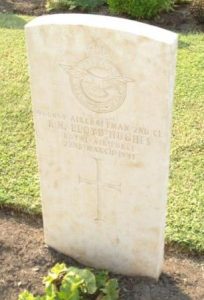Llanymynech is a village straddling the border between Montgomeryshire and Shropshire, which lies about nine miles north of Welshpool on the A483 to Oswestry, and on the crossroads with the B4398. The village lies on the banks of the river Vyrnwy, and the Montgomery Canal passes through it. The border runs through the village, so part of the village is in England, part in Wales. To the north of the village is the smaller village of Pant. The men of both villages who fell during both World Wars are commemorated on a war memorial, in the form of a Celtic Cross, which is situated in Llanymynech next to the road, at the junction of Rectory Lane. The memorial was unveiled by Colonel Sir John Vaughan Campbell, VC, CMG, DSO.
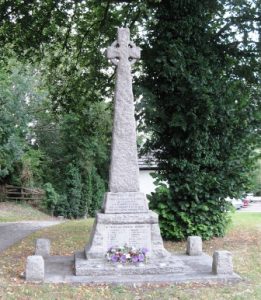
The Great War, 1914-1918
James Jackson Brown, Lance Corporal, 26504, King’s Shropshire Light Infantry. James was born in Liverpool in 1895, the son of Edward and Sophia Brown. His father was a Policeman from Aberhafesp, and prior to the war had moved his family back to Brook House, Pant. James worked as a Butcher prior to enlisting into the Montgomeryshire Yeomanry at Welshpool. He was probably posted to the 3/1st Battalion, at Park Hall Camp, Oswestry, before being drafted to France in the summer of 1917, and transferred to the 7th Battalion, King’s Shropshire Light Infantry. The battalion was by then attached to 8 Brigade, 3rd Division, and was rebuilding at Lebucquière following heavy losses during the Battle of Arras. On 4 September the battalion moved to the Ypres Salient with the Division to join the great Passchendaele offensive, and on 26 September took part in the Battle of Polygon Wood. The 7th KSLI suffered heavy casualties during the battle, as did the entire Division, which then transferred south to the Renescure area, near St. Omer to rest and rebuild before moving to the Noreuil-Bullecourt sector. The Division enjoyed a relatively peaceful winter, escaping the main action at Cambrai, and holding various sections of the front, facing Croisilles. On 21 March 1918 the Germans launched the first phase of a massive offensive, along the sector of line running from Croisilles south to La Fère, and the 3rd Division became caught up in the terrible fighting which ensued. The battered Division was relieved on 20-30 March and moved back into reserve to rebuild, before being transferred north, to the Lys Sector, taking up positions east of the La Bassée Canal. Unfortunately, the second phase of the German offensive was launched in this sector on 9 April, and the Division again became caught up in several weeks of terrible fighting. The Germans transferred their focus south, to the Aisne sector in May, so the 3rd Division, in the Locon area, settled into a summer of regular trench warfare. The Allies launched a great offensive along the Western Front on 21 August 1918, and the 3rd Division, now back in the Monchy area, was ordered to assault the Bapaume-Arras railway east of Courcelles. Over the coming weeks the Allies advanced, and by 27 September the 3rd Division was in place ready to assault the Canal du Nord. James was wounded here during the assault, near Flesquières, and was evacuated to the 38th Casualty Clearing Station, where he died of his wounds on 29 September 1918. The 23-year-old is buried in Sunken Road Cemetery, Boisleux-St. Marc, France.
Thomas Robert Ellis, Private, 22382, King’s Shropshire Light Infantry. Thomas was the son of James and Sarah Ellis, of Chapel Road, Llanymynech. He worked as a house painter prior to the war, and married Winifred Charlotte Roberts, of Shrewsbury, early in 1916. Thomas enlisted into the King’s Shropshire Light Infantry at Shrewsbury soon after, and after completing his training, was drafted to France in the winter of 1916-17, joining the 7th Battalion, King’s Shropshire Light Infantry. The battalion was attached to 3 Brigade, 3rd Division, and had suffered heavy casualties during the Somme offensive of 1916, before moving to the Arras sector in January 1917. The 7th KSLI then began work on tunnels in the cave system beneath Arras, before the Brigade began to prepare for an attack on Tilloy, taking over the trenches opposite the village by 31 March. Four days later the British opened up a gas attack upon the German lines, which the Germans retaliated to by pounding the Divisions lines with heavy artillery fire. The 7th KSLI sheltered in tunnels, before assembling in Blenheim Cave, preparatory to the attack, which was launched on 9 April 1917. The Arras offensive, which opened that day, took place over a stretch of line running from Croisilles to Givenchy, and the 3rd Division played an important role, with its assault on Tilloy that day. The Division saw heavy fighting around Tilloy during the day, then rested over the night before attacking again the following morning and capturing the Feuchy-Wancourt Line. The Division then returned to Arras to rest before returning to the line by 23 April, to resume the offensive. Thomas was killed in action near Monchy on 25 April 1917. The 29-year-old has no known grave and is commemorated on the Arras Memorial, France.
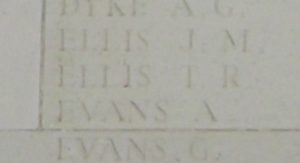
Harold Hooton, Private, M2/049876, Royal Army Service Corps. Harold was born in Salford in 1889, the son of Richard and Edith Hooton. He worked as a Chauffeur prior to the war, and married Alice Louise Kynaston, of Pant, on 4 August 1910. Harold enlisted into the Army Service Corps at Manchester on 16 February 1915, and was posted to the ASC Depot at Grove Park. On 20 March 1915 he embarked for France, and was posted to the Anti-Aircraft Depot. Harold served in France for almost three years before his health began to suffer, and he was discharged from the ASC as medically unfit on 15 June 1918. Harold and his wife Alice then moved to Brynterion, Llanymynech. Harold eventually died of disease at Shrewsbury Hospital on 17 October 1923, aged 34. Nothing further is known of him, as he is not commemorated by the CWGC. Harold is not commemorated on the Llanymynech war memorial.
John Herbert Humphreys, Gunner, 188358, Royal Field Artillery. John was the son of William and Mary Humphreys, of Walnut Tree House, Pant. He enlisted at Oswestry into the Royal Field Artillery, and after completing his training, was posted to the 465th Battery, 65th Brigade, Royal Field Artillery, which was equipped with 18-pdr guns. The 65th Brigade, RFA embarked for France at Southampton on 3 May 1917, and disembarked at Le Havre before entraining for Abeele, moving into the Ypres Salient. The Battery then moved to Godewaersvelde for training, before moving their guns into position at Reninghelst on 14 May for instruction alongside the 41st Division Artillery. By 1 June the Brigade had moved to positions near Dickebusch, and took part in the softening-up procedure for the Battle of Messines Ridge, which was launched on 7 June, targeting German positions and strong-points in the days leading up to the offensive. The Brigade did not play a part in the artillery support to the main Passchendaele offensive, which was launched on 31 July, but three days later came under the control of the 18th Division artillery, and began supporting the Divisions infantry. The Brigade was still in action on 25 October when 465 Battery was hit by German counter-battery fire, suffering one officer and a number of men wounded by shrapnel. John was among the wounded, and was evacuated to the 4th Casualty Clearing Station, where he died of his wounds three days later, on 28 October 1917. The 19-year-old is buried in Dozinghem Military Cemetery, Belgium. He had reportedly only been at the front a number of weeks.
David John Jeffreys, Leading Aircraftman, 96585, Royal Air Force. David was the son of William and Lucy Hannah Jeffreys, of Temperance House, Llanymynech. He worked as a Postman prior to enlisting into the Royal Flying Corps on 17 September 1917. David continued to serve after the Royal Flying Corps merged with the Royal Naval Air Service to form the Royal Air Force on 1 April 1918, and had served in Egypt during the war before joining the Aeroplane Supply Depot. David was transferred to the RAF reserve on 5 Feb 1920, and discharged at Shrewsbury on 30 April, returning to Llanymynech. Sadly, after surviving the war, David died of influenza at home on 25 December 1920. The 22-year-old is buried in St. Agatha Churchyard, Llanymynech. David is not commemorated on the Llanymynech war memorial.
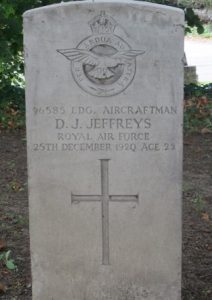
Ernest Wynn Leonard Jones, Private, 291840, Welsh Regiment. Ernest was born at The Windmill, Sweeney Mountain in 1899, the son of William and Eleanor Jones. Prior to the war the family had moved to Mount Pleasant, Pant. Ernest enlisted into the Training Reserve soon after his 18th birthday, and was posted to the 7th (Cyclist) Battalion, Welsh Regiment. After completing his training, he was drafted to France in the Summer of 1918, joining the 15th Battalion, Welsh Regiment. The battalion, known as the Carmarthen Pals Battalion, due to its Carmarthenshire roots, was on the Somme with 114 Brigade, 38th (Welsh) Division, holding the line near Aveluy Wood, facing Thiepval Ridge across the valley of the River Ancre. On 21 August 1918 the 15th Welsh waded across the River Ancre and assaulted Thiepval Ridge, before the remainder of the Division attacked from Black Horse Bridge to Albert, and within days the Division had captured Thiepval Ridge and Pozieres, before advancing across the old Somme battlefields of 1916, towards Longueval and Delville Wood. Following the clearing of the wood, the Division continued its advance and reached the villages of Morval and Sailly-Saillisel before the end of the month. Ernest was killed in action near Morval on 4 September 1918. The 19-year-old has no known grave, and is commemorated on the Vis-en-Artois Memorial, Haucourt, France. (Ernest is named on the Llanymynech memorial as L Jones).
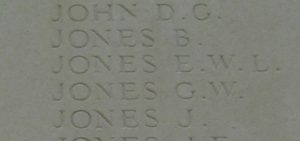
George Thomas Jones, Acting Bombardier, 56504, Royal Field Artillery. George was born at Llanymynech on 31 October 1887, the son of John and Sarah Jones. He worked as a Fireman at Chester prior to the war, and had married Edith Parry there on 14 December 1914. George enlisted into the Royal Field Artillery at Chester soon after the outbreak of war, and was posted to D Battery, 104th Brigade, RFA. He embarked for France with the Brigade on 25 August 1915, and the Brigade then moved to the Tilques Area as part of the 23rd Division. The Division saw its first major action during the Somme offensive, then during December 1916 the Division was relieved from the Somme, moving north to Flanders. On 18 January 1917 the 104th Brigade left the 23rd Division, and became an Army Brigade, moving to the Ypres Salient, and taking up positions near Belgian Chateau. The Brigade remained here over the coming months, providing artillery support from new positions at Swan Chateau for the assault on Messines Ridge on 7 June 1917. The Brigade then moved north to positions at The Bluff Tunnels, and set up its guns there. George was wounded soon afterwards, and was evacuated to Hospital at Étaples, where he died of his wounds on 7 July 1917. The 29-year-old is buried in Étaples Military Cemetery, France. His brother, Joseph, had been killed on the Somme in 1916. Neither of the brothers is commemorated on the Llanymynech war memorial.
John Jones, Private, 6828, King’s Shropshire Light Infantry. John was born at Pant in 1881, the son of John and Annie Jones. He enlisted into the King’s Shropshire Light Infantry in 1907, and at the outbreak of war was serving with the 2nd Battalion, King’s Shropshire Light in Secunderabad, India. The battalion sailed from Bombay on 13 October, landing in Plymouth in November, and moved to Winchester to join 80 Brigade, 27th Division. The Division then embarked for France, landing at Le Havre on 21 December 1914, moving to Flanders to join the BEF and relieving a French Division. John did not embark straight away, but joined the battalion in billets at Dickebusch on 18 February 1915. Although the Division was by now holding front-line trenches in a hostile sector, it did not see its first major action until the Germans had attacked the 27th Division near St. Eloi on 14 February. John joined the battalion as part of a draft of 183 men just after this German attack had been stopped. The Division then made a successful assault on 28 February, alongside the Canadians, before settling back into the normal routines of trench warfare over the coming weeks, usually spending four days in the front line, four in support and four in reserve. On 25 March the 2nd KSLI went out of the line to Reninghelst, where the men undertook a series of drills, before moving sectors, and taking over trenches at Polygon Wood. The Germans launched a gas attack, the first in history, against French Colonial troops to the north of the 27th Division on 22 April 1915, heralding the beginning of the Second Battle of Ypres, and the 27th Division took part in the counter-attack which followed, seeing heavy fighting over the coming days. By 9 May 1915 the 2nd KSLI was holding the line at Railway Wood, when their lines were shelled by German artillery. John was killed when a shell exploded in his trench during the bombardment that day. The 34-year-old has no known grave and is commemorated on the Ypres (Menin Gate) Memorial, Belgium.
Osborne Jones, Private, 67840, South Wales Borderers. Osborne was the son of Joseph and Elizabeth Jones, of Upper House, Pant. He enlisted into the army at Shrewsbury on 28 April 1918, and was posted to the 53rd (Young Soldiers) Battalion, South Wales Borderers at Kinmel Park for training. The Young Soldiers Battalions had been formed to train men recruited as conscripts under the Military Service Act 1916 who were aged up to 18 years and 5 months. Upon reaching 18 years and 5 months, the recruits would be posted on to a Graduated Battalion, before being drafted to front-line units. Osbourne was to never reach this age, as sadly he became ill during training, and died of bronchial pneumonia at Kinmel Park Military Hospital, Bodelwyddan on 9 October 1918. The remains of the 17-year-old were brought home for burial in St. Agatha’s Churchyard, Llanymynech. His step-brother, Robert Jones, was killed in France in 1918.
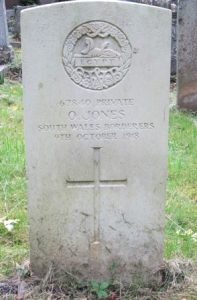
Joseph Jones, Lance Corporal, 17036, Royal Welsh Fusiliers. Joseph was born in Pant in 1886, the son of John and Sarah Jones. By 1901 he was living at Whitby, Cheshire, with his sister Harriett and her husband. By 1911 he was living at Ellesmere Port, and he married Elizabeth Chatten there in August 1912. Joseph enlisted into the 3rd Battalion, Royal Welsh Fusiliers at Chester on 7 November 1914, and was posted to Litherland Camp, Liverpool for training. Joseph embarked for France on 4 May 1915, and joined the Infantry Base Depot, before being drafted to the 2nd Battalion, Royal Welsh Fusiliers. The battalion was at Bois Grenier, attached to 19 Brigade, 6th Division. On the following month the Brigade transferred to the 27th Division, and on 19 August the Brigade transferred again to the 2nd Division, joining the Division at Bethune. On 24 August the 2nd RWF took over trenches at Cuinchy, then by 20 September took over trenches at Maison Rouge for a short tour, prior to moving to Cambrin on 25 September 1915, taking part in the opening offensive of the Battle of Loos that day. The battalion fought throughout the offensive, then on 25 November 1915 the Brigade transferred again, joining the newly arrived 33rd Division, which had moved to the Givenchy sector. The Division remained in the Givenchy Sector over the winter, and at dawn on 22 June 1916 the Germans detonated a huge underground mine beneath the trenches held by the 2nd RWF, killing 150 men, before launching an attack upon the stunned survivors. The battalion stubbornly held onto their lines, despite heavy losses, leading to the crater being named Red Dragon Crater. At the beginning of July 1916, the Division was relieved and moved south to the Somme, reaching Méaulte by 15 July, then the men marched past the shattered remains of Mametz Wood, to positions facing High Wood. At dawn on 20 July 1916 the Division attacked High Wood, with the 2nd RWF initially in support. The battalion was heavily shelled before advancing into the wood to join the fight that morning, and suffered heavily. Joseph had been killed in action sometime during that day. The 30-year-old was originally buried on the battlefield, but after the war his grave was exhumed, and he was re-buried in Caterpillar Valley Cemetery, Longueval, France. His brother, George Thomas Jones, was killed in 1917. Neither man is commemorated on the Llanymynech war memorial.
Robert Jones, Private, 15062, King’s Shropshire Light Infantry. Robert was the son of John and Elizabeth Jones, of Ratcliffe Hill, Llanymynech. His mother had been widowed prior to 1891, and re-married Joseph Jones, of Pant, in 1893. The couple then lived at Cross Guns, Llanymynech, before moving to Underhill Cottage, Pant. Robert worked as a quarryman prior to enlisting into the King’s Shropshire Light Infantry at Oswestry on 28 October 1915, and was posted to the Depot at Shrewsbury. He embarked for France on 7 April 1915, joining the 1st Battalion, King’s Shropshire Light Infantry, which was attached to 16 Brigade, 6th Division, and was wounded just weeks later, being shot in the head whilst in the trenches near Armentieres on 5 May, being treated at the 2nd Stationary Hospital at Boulogne, before returning to England for treatment. On 2 January 1916 Robert returned to France, re-joining the 1st KSLI, which by then was in positions at La Brique. He was wounded again less than two months later, being hit by shrapnel in the back of the head on 9 February 1916, and was again treated at Boulogne. By 5 March 1916 had made it back to the King George Hospital in London, where he was treated for his wounds. Unfortunately, he had suffered paralysis of his right arm, as well as speech issues and problems with his vision, and had shards of shrapnel removed from his skull. Robert was discharged from the army as medically unfit on 19 June 1916 and returned home to Llanymynech, but over the coming years his health deteriorated due to his wounds, and he died of influenza on 10 November 1918, the day before the Armistice was signed. Robert was buried in St Agatha’s Churchyard, Llanymynech. His step-brother, Osbourne, had died just weeks previously.
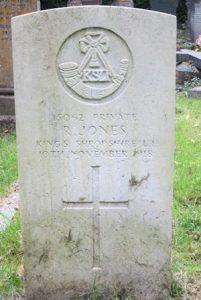
William Edward Jones, Sergeant, 202810, King’s Shropshire Light Infantry. William was the son of John and Mary Anne Jones, of 3 Bradford Terrace, Llanymynech. He worked at Chester Post Office prior to the war, and was a member of the 4th Battalion, King’s Shropshire Light Infantry, a Territorial Army battalion. The battalion mobilised at Shrewsbury on 4 August 1914, attached to the Welsh Division, moving to Cardiff soon afterwards. In September the battalion left the Welsh Division and moved to Sittingbourne, then on 29 October 1914 embarked at Southampton for India joining the Middlesex Brigade, Home Counties Division at Bombay. The battalion was then sent to Singapore, arriving there on 10 February 1915, with a detachment going to the Andaman Isles. During April 1915 two Companies were sent to to Hong Kong. All of these men were used for garrison duties over the coming months, before concentrating at Singapore on 13 April 1917, sailing for Colombo, then sailed for Cape Town, before landing at Plymouth on 29 June 1917. On 27 July the battalion re-embarked at Southampton and landed at Le Havre two days later, entraining for Maroeuil, to join 190 Brigade, 63rd (Royal Naval) Division. On 11 September the 4th KSLI went into the front line at Maroeuil to have their first taste of trench warfare, then two weeks later the Division was relieved, before heading to the Ypres Salient, to join the great Passchendaele offensive, taking over positions on the Canal Bank by 25 October. The Division then prepared to move forwards into the front line on the slopes of Passchendaele Ridge, and on 30 September took up positions in the position known as Albatross Ridge, launching their assault on the ridge that morning. William was killed here on the following day, 31 October 1917. The 27-year-old is buried in St. Julien Dressing Station Cemetery, Belgium. (William is named on the memorial as E. Jones).
Thomas Lloyd, Private, 9893, King’s Shropshire Light Infantry. Thomas was born in Wolverhampton in 1894, the son of Thomas and Emma Lloyd. His mother had died by 1901, and his father later moved to 44, St. Owen’s Street, Hereford. Thomas was living in Chapel Cottage, Cockshutt by 1911, where he worked as a Groom. Thomas then lodged with Mrs Saddler, at Railway Cottage, Pant, but by 6 March 1912 had enlisted into the King’s Shropshire Light Infantry. At the outbreak of war, Thomas was serving with the 1st Battalion, King’s Shropshire Light Infantry, which was in Tipperary attached to 16 Brigade, 6th Division. The Division sailed from Queenstown for Holyhead on 15 August, entraining for Cambridge before embarking for France and on 10 September 1914 landed at St. Nazaire, entraining for the Aisne to join the BEF at Vailly. The Allies secured a famous victory on the Aisne, stopping the German drive on Paris, so the BEF then moved north to Flanders, to guard the ancient city of Ypres. The 1st KSLI entrained at Fismes on 13 October, and travelled overnight, passing through Amiens before moving through Boulogne and Calais before detraining at Cassel, where the battalion went into billets. On 15 October the battalion marched out of Cassel to billets between Outtersteene and Bailleul, where machine-gun fire could be heard in the distance, from the direction of Steenwerck. On 17 October the battalion marched through Sailly-sur-la-Lys, before moving into positions north-east of Rouge du Bout, before moving to Bois-Grenier two days later. On 20 October the 1st KSLI took over a section of the line at Bois-Grenier, suffering several men wounded by shellfire. The following day was a relatively quiet one, spent watching the Germans digging in and excavating new lines, but on 22 October 1914 the battalion was pounded by German artillery fire, suffering twelve men killed and 23 wounded. Thomas was among the men killed that day by the shellfire. The 20-year-old has no known grave and is commemorated on the Ploegsteert Memorial, Belgium.

Edward Townshend Logan, DSO, Lieutenant Colonel, Durham Light Infantry. Edward was born at Valparaiso, Chile on 6 November 1865, the son of Edward Logan and Emily Eliza Logan (nee Townsend), the daughter of Lee Porcher Townsend, of Wincham Hall, Cheshire. Edward was educated at Westminster School, before being commissioned as Second Lieutenant into the 3rd (Reserve) Battalion, Cheshire Regiment on 27 June 1888, and became a career soldier, serving in the Second Boer War, where he was Mentioned in Despatches twice and was awarded the Distinguished Service Order. By 1906 he had been promoted to Major, and on 22 January 1906 he married Hilda Emma Francis Johnston, the daughter of Carruthers Charles Johnston, of Chorlton Hall, Chester. On 6 April 1912 Edward was promoted to Lieutenant Colonel, and was given command of the 3rd Battalion, Cheshire Regiment at Birkenhead. By now his sister, Isabelle, had married Jasper Moon, of and his mother Emily was living with the couple at Llwyn-y-Groes, Llanymynech. By the outbreak of war, his mother was residing at Great Ness Hall, Great Ness. Following the outbreak of war, he was given the command of the newly formed 15th Battalion, Durham Light Infantry. The battalion had formed at Newcastle before moving to Halton Park to join 64 Brigade, 21st (Light) Division, and on 11 September 1915 the battalion landed at Boulogne, moving with the Division to the Loos sector. The Battle of Loos was launched on 25 September 1915, and the freshly arrived and inexperienced Division was sent into action at Vermelles on the following day. Edward led his battalion forwards to occupy the old German front line, before receiving orders to attack Hill 70, alongside the Guards Division, and at 11.30 he moved his men forwards, leading from the front. Edward was killed just fifteen minutes later. The 49-year-old has no known grave, and is commemorated on the Loos Memorial, France. His brother, Roland, was killed at Ypres a month later, whilst another brother, Balfour, had died whilst serving in India on 1 January 1898. Out of the three brothers, only Roland is commemorated on the Llanymynech war memorial.
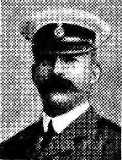
Roland Octavius Logan, Captain, Oxfordshire and Buckinghamshire Light Infantry. Roland was born at Upton, Cheshire on 30 May 1882, the son of Edward Logan and Emily Eliza Logan (nee Townsend), the daughter of Lee Porcher Townsend, of Wincham Hall, Cheshire. Roland was educated at Moorland House, Heswell and Radley College, Oxford, before being commissioned as Second Lieutenant into the Oxfordshire and Buckinghamshire Light Infantry on 8 January 1901. He served during the Second Boer War, and remained with the regiment afterwards, being promoted to Lieutenant on 3 October 1904, and Captain on 19 November 1910. By now his sister, Isabelle, had married Jasper Moon, of and his mother Emily was living with the couple at Llwyn-y-Groes, Llanymynech. By the outbreak of war, his mother was residing at Great Ness Hall, Great Ness. Roland still serving with the regiment, was posted to the 5th Battalion, Oxfordshire and Buckinghamshire Light Infantry, which had formed at Oxford in August 1914, before joining 42 Brigade, 14th (Light) Division at Aldershot. On 21 May 1915 the battalion landed at Boulogne, and moved with the Division to Rubrouck, in Flanders. By 28 May the Division had moved to Steenvoorde, before marching into the Ypres Salient over the coming days, taking over trenches south-west of Ypres, at Dranoutre, where the infantry battalions of the Division began the normal routines of trench rotation: usually four days in the front line; four in support; and four in reserve. On 15 June the Division took over trenches in the dreaded Hooge sector, and on 20 June the 5th Ox & Bucks LI moved into the front line at Railway Wood to begin a routine tour, and two days later carried out a raid on the Germans opposite, suffering a number of casualties before returning to their own lines. The battalion was relieved on the night of 25 June, and whilst in reserve missed the Divisions terrible ordeal during the Action of Hooge, where it infamously became the first Division to be attacked by the German use of flamethrowers. Routine trench warfare then resumed, albeit in this hostile sector, then on 25 September 1915 the Division took part in a diversionary attack on Bellewaarde, to attempt to divert German attention away from the main offensive at Loos, to the South. Roland’s battalion then enjoyed a prolonged spell in reserve at Poperinghe, resting and rebuilding, before moving back into the front line at Railway Wood by 13 October to begin a prolonged tour, and at dawn on 17 October the Germans exploded a mine beneath one of the battalion positions, destroying four firing bays, and creating a crater. The Germans attacked soon after, in an attempt to take the crater, but were beaten off in a determined counter-attack. Roland, Second Lieutenant Melliss and thirteen men were missing, believed killed in the mine explosion, whilst another 22 men had been killed. Two days later the battalion was relieved and moved back to the Seminaire Redoubt, near Ypres. Roland’s body, together with that of Lieutenant Melliss, were later recovered and buried beside the roadside of the Menin to Roulers road. After the war their graves were exhumed, and both men were buried together in Birr Cross Roads Cemetery, Belgium. Roland was 33-years-old. His brother, Edward, had been killed at Loos the previous month, while another brother, Balfour, had died whilst serving in India on 1 January 1898. Out of the three brothers, only Roland is commemorated on the Llanymynech war memorial.
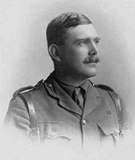
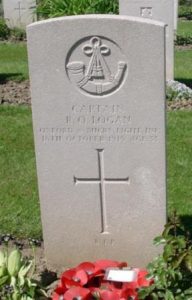
Richard John Morgan, Private, 3304, Montgomeryshire Yeomanry. Richard was the son of Thomas and Elizabeth Morgan, of Cross Keys Cottage, Llanymynech. He worked as a farm servant at Wernlas, Maesbrook prior to the war. Richard enlisted into the 3/1st Battalion, Montgomeryshire Yeomanry soon after the outbreak of war, and was posted to Park Hall Camp, Oswestry for training. Richard took ill during the spring of 1916, and was sent to the Chester War Hospital, where he was treated for diphtheria. Unfortunately, he died of diphtheria in hospital on 27 June 1916. The remains of the 21-year-old were brought back home, and he was buried with full military honours in St. Agatha’s Churchyard, Llanymynech.
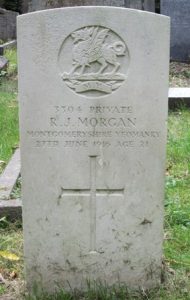
John Morris, MC, Major, Royal Army Medical Corps. John was born on 20 February 1879, the son of Thomas Morris and Mary Ellen Morris (nee Hughes), of Llansilin. He trained as a Surgeon at Edinburgh University, graduating in 1904, and had been assistant surgeon to the Dinorwic Quarries Hospital and as house-surgeon of the Denbighshire Infirmary, by 1905. John married Ellen Mary Cooper in 1910, and the couple lived at Boston Bank, Hyde, Cheshire, where John had started his own practise. He enlisted into the Territorial Army on 8 March 1912, and became the Medical Officer to the 6th Battalion, Cheshire Regiment. John embarked for France on 10 November 1914, and by August 1915 had been promoted to Captain, then later to Major. He was awarded the Military Cross in the New Year Honours List of 1 January 1917. Twelve months later he had been promoted to Major, and was serving with the 132nd Field Ambulance, RAMC, as second-in-command. The unit was attached to the 39th Division, but following heavy losses by the Division during the Spring of 1918, it was removed from the line, and the 132nd FA left the Division in June 1918, moving to Abbeville to re-equip, before moving to Flanders to train US Army Medical Units. On 4 September 1918 the 132nd FA entrained for the front again, to join the great Allied offensive. On 5 October 1918 the 132nd FA moved forward to Templeux-le-Guerard, taking over from the 6th Australian Field Ambulance. John was sent with the advance party to begin setting up the unit, and to take over command of the Ambulance once it had set up, ready to take further casualties. During the afternoon of 7 October 1918, John was visiting a forward Regimental Aid Post when he was killed. His body was carried back by men of his unit, and the 39-year-old was buried in Bellicourt British Cemetery, France.
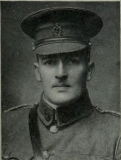
John Owen, Corporal, 241269, Cheshire Regiment. John was the son of John and Mary Elizabeth Owen, of Hillside, Pant. He lived with his wife, Lily Owen, in Altrincham, Cheshire prior to the war. John enlisted at Cheadle into the Cheshire Regiment, and was posted to France early in 1917, joining the 1/5th Battalion, Cheshire Regiment. The battalion was by then the Pioneer Battalion to the 56th (London) Division, and was in the Arras sector when John arrived, and all of the men were employed on road maintenance. The Division then fought at the Battle of Arras, before being transferred north to the Ypres Salient, taking part in the Battle of Langemarck. The Division was then transferred south again, and took part in the Battle of Cambrai, remaining in the area for the winter. The Division was in the Arras sector when the German Spring Offensive was launched on 21 March 1918. The 5th Cheshire’s were at work at Ste. Catherine when the Germans began their preliminary artillery bombardment, and took up defensive positions with the Division on the Green Line until 27 March, when it relieved the Canadians at Arleux. The main fighting was raging to the south, as the first phase of the German attack had been on the section of front running south from Croisilles to La Fère, so the Division escaped the worst of the fighting until 28 March, when it was subjected to a full-frontal attack. Heavy fighting ensued over the coming days, but by 9 April German attention had moved further north, as they launched the second phase of their offensive along the Lys Valley. The Arras sector quietened down, and the 5th Cheshire’s began work on trench consolidation work over the coming weeks. John was wounded whilst the battalion was working on the Blangy System at the end of May, and was evacuated to Hospital in Aubigny, where he died of his wounds on 3 June 1918. The 25-year-old is buried in Aubigny Communal Cemetery Extension, France. He is not commemorated on the Llanymynech war memorial.
Robert Owen, Corporal, 290108, Royal Welsh Fusiliers. Robert was the son of Albert and Caroline Owen, of Yates Cottage, Pant. He worked as a quarryman prior to the war, and had enlisted at Llansantffraid into the 7th Battalion, Royal Welsh Fusiliers on 22 April 1912. The battalion was a Territorial Army unit, and Robert attended the Annual TA Summer Camps over the coming years. The battalion mobilised for war at Newtown in August 1914, as part of North Wales Brigade, Welsh Division and moved to Conway until the end of the month, before moving to Northampton. In December the Division moved to Cambridge and then in May 1915 to Bedford, where the Division was numbered and the formation became 158 Brigade, 53rd (Welsh) Division. On 19 July 1915 the entire Division sailed from Devonport for Imbros and on 9 August 1915 landed at Suvla Bay. The infantry moved off the beaches into the bush, but due to a lack of maps and no knowledge of the terrain, many of the units became disorientated, and the situation became chaotic. Robert was shot in the arm on the following day, and was eventually evacuated back to England aboard the Hospital Ship Aquitania. Upon recovering, he embarked for Egypt at Devonport on 17 January 1916, and by 10 February had re-joined the 1/7th RWF. The 53rd (Welsh) Division had been helping guard the Suez Canal before taking part in operations to drive the Turks out of the Sinai. The EEF then turned its attention onto driving the Turks out of Palestine, and on 26 March 1917 launched its first offensive against the coastal city of Gaza, which guarded the road to Jerusalem. Initial gains during the day were lost when the assaulting divisions lost touch with each other and communication broke down when a thick fog cloaked the battlefield. Robert was killed in action during the fighting that day. The 24-year-old is buried in Gaza War Cemetery. By then, his parents had moved to 10, Plains Terrace, Marsden, Huddersfield.
William Peate, Private, 16317, King’s Shropshire Light Infantry. William was the son of John Edwin Lloyd Peate and Elizabeth Peate, of Verniew House, Llanymynech. He was a farm-worker at Ty Gwyn Farm, Llanymynech prior to the war. William enlisted into the 7th Battalion, King’s Shropshire Light Infantry at Shrewsbury soon after the outbreak of war. The battalion had formed at Shrewsbury in September 1914, before joining 76 Brigade, 25th Division at Codford, Salisbury Plain. On 28 September 1915 the battalion landed at Boulogne, before moving to the Ploegsteert Sector with the rest of the Division. On 15 October, 76 Brigade transferred to the 3rd Division, and four days later the 7th KSLI transferred to 8 Brigade, in the same 3rd Division. The Division was in billets at Steenvoorde, resting, before taking over positions in the Ypres Salient, near Sanctuary Wood. The battalion remained at Ypres over the winter, until the 3rd Division was withdrawn on 2 February 1916 and moved back to the rest area at Eperlecques. The Germans attacked The Bluff soon afterwards, and 76 Brigade was sent back to help in its recapture. At the end of the month the remainder of the Division returned to The Bluff, and endured a miserable spell in the line, interspersed with a spell in the Spoil Bank trenches, also a particularly hostile sector. On 1 July 1916 the Division moved out of the Salient and began to move south to join the great Somme offensive. On 14 July the 7th KSLI took part in its first assault on the Somme, when the Division attacked Bazentin Ridge, and was almost annihilated, with only six officers and 135 other ranks emerging unscathed. The survivors then moved back to Montauban, where the battalion was rebuilt, and by 18 August had moved back into the line, supporting an assault by the 10th RWF on Maltzhorn farm, south-east of Montauban, capturing Lonely Trench. The battered 3rd Division was then relieved and moved to the Mazingarbe area to rest, holding the line there for several weeks, before returning to the Somme by 8 October, and took over the line facing Serre. The next, and final, phase of the Somme offensive, the Battle of the Ancre, was launched at dawn on 13 November 1916, and the 7th KSLI took part in the assault on Serre that day. Conditions were terrible, the battlefield had turned into a thick mud, and fog cloaked the area, so the attack was a failure. William had been killed in action at some time during the day. The 23-year-old has no known grave and is commemorated on the Thiepval Memorial, France.
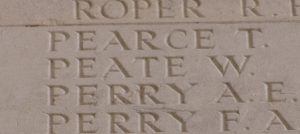
Edward Phillips, Private, 9781, King’s Shropshire Light Infantry. Edward was born at Llanymynech in 1890, the son of John Phillips. By 1891 he was living with his grandparents, George and Ann Owen, at Wern, Llanymynech. His mother must have died when he was an infant, as his father later remarried. Edward was still living at Wern by 1911, working on his grandparent’s nursery, but soon afterwards had enlisted at Shrewsbury into the King’s Shropshire Light Infantry. At the outbreak of war Edward was serving with the 1st Battalion, King’s Shropshire Light Infantry, which was in Tipperary attached to 16 Brigade, 6th Division. The Division sailed from Queenstown for Holyhead on 15 August, entraining for Cambridge before embarking for France and on 10 September 1914 landed at St. Nazaire, entraining for the Aisne to join the BEF at Vailly. The Allies secured a famous victory on the Aisne, stopping the German drive on Paris, so the BEF then moved north to Flanders, to guard the ancient city of Ypres. The 1st KSLI entrained at Fismes on 13 October, and travelled overnight, passing through Amiens before moving through Boulogne and Calais before detraining at Cassel, where the battalion went into billets. On 15 October the battalion marched out of Cassel to billets between Outtersteene and Bailleul, where machine-gun fire could be heard in the distance, from the direction of Steenwerck. On 17 October the battalion marched through Sailly-sur-la-Lys, before moving into positions north-east of Rouge du Bout, before moving to Bois-Grenier two days later. On 20 October the 1st KSLI took over a section of the line at Bois-Grenier, suffering several men wounded by shellfire. The following day was a relatively quiet one, spent watching the Germans digging in and excavating new lines, but on 22 October 1914 the battalion was pounded by German artillery fire, suffering twelve men killed and 23 wounded. Edward had been wounded at some time, and returned to England for treatment. Upon recovering, he was posted to the 8th Battalion, King’s Shropshire Light Infantry, which was attached to 66 Brigade, 22nd Division. On 28 October 1915 the Division sailed from Marseilles for Salonika, as part of an Anglo-French force sent to bolster the beleaguered Greek army, following the combined Australian and Bulgarian offensive into Serbia. Edward survived several battles in Salonika, but somehow suffered terrible burns in May 1918, dying as a result on 8 May 1918. The 27-year-old is buried in Salonika (Lembet Road) Military Cemetery, Greece.
Joseph Arthur Powell, Gunner, 114603, Royal Garrison Artillery. Joseph was the son of Joseph Powell and Ann Powell (nee Jones), of 15, Oswald Place, Upper Brook Street, Oswestry. He married Margaret Ellen France Griffiths at St. Agatha’s Church, Llanymynech on 4 June 1908, and the couple set up home at 1 Greenwich Cottage, Pant. Joseph worked as a bricklayer prior to enlisting into the Royal Garrison Artillery at Oswestry on 10 December 1915, and was initially placed on the Army Reserve. Joseph was mobilised on 25 August 1916 and posted to the RGA Depot at Portsmouth. He was initially posted to the 34th Company, RGA, but after embarking for France on 13 August 1917 was posted to the 145th Siege Battery, RGA at Ypres, reaching his new unit on 25 August. The battery was hard at work, supporting the Allied offensive at Passchendaele, and the battle was at its height when Joseph arrived. Sadly, he was killed in action just a week later, on 2 August 1917. The 36-year-old is buried in Bleuet Farm Cemetery, Belgium.
Joseph Roberts, Gunner, 116963, Royal Field Artillery. Joseph was the son of William and Elizabeth Roberts, of The Gin House, Pant. He worked as a limestone quarryman prior to the war. Joseph enlisted into the Royal Field Artillery at Oswestry, and after completing his training was posted to France, joining C Battery, 251st Brigade, Royal Field Artillery. The Brigade had fought during the Battle of Arras and then at Passchendaele in 1917, wintering at Frezenberg, in the Ypres Salient. The Brigade moved south in March 1918, and became caught up in the desperate defensive action which followed the launching of the German Spring offensive on 21 March 1918, firing at the advancing German troops from the Bertaucourt area, south of La Fère, the southern-most point of this first German offensive. The Brigade then moved to positions at Thézy, and supported troops fighting along the Amiens to St. Quentin road, around Villers-Bretonneux. From 8 August onwards the Brigade advanced to Chipilly and supported the Allied assault on 8 August 1918 which broke the German will, before moving to Arras and joining the great advance from 21 August 1918. Joseph was captured by the Germans and taken prisoner of war around this time, and he died in captivity on 4 October 1918. The 32-year-old was buried in Glageon Communal Cemetery Extension, France.
John Harold Shaw, Sergeant, 1720, Royal Field Artillery. John was the son of Thomas and Elizabeth Shaw, of Didsbury, Manchester. He married Bertha Bagley, of Llanfyllin, at Ardwick on 14 June 1907, and the couple lived at 98, Old Elm Street, Ardwick, Manchester. John enlisted into the 1/2nd East Lancs Brigade, Royal Field Artillery at Shaw, Lancashire soon after the outbreak of war. The unit was a Territorial Army unit, attached to the East Lancashire Division. It did not embark for Egypt with the Division when it sailed from England in September 1914, but reached Egypt on 14 June 1915 and did not proceed to Gallipoli, remaining on the Suez Canal Defences instead. The brigade was re-equipped with modern 18-pounder field guns on 22 February 1916. Soon afterwards, John took ill, and was sent to Hospital in Cairo, where he died of tuberculosis on 27 March 1916. The 35-year-old is buried in Cairo War Memorial Cemetery, Egypt. His widow, Bertha, returned to live at Wernfield Cottage, Pant with their two children, but died on 23 July 1922, aged 39. John is not commemorated on the Llanymynech war memorial.
James Louis Spencer, Lance Corporal, 22602, Grenadier Guards. James was the son of James and Alice Spencer, of Penyvoel, Llanymynech. He was educated at Llanymynech C.E. School, and had been awarded a bursary to the Llanfyllin County School prior to enlisting at Bromley into the Grenadier Guards soon after the outbreak of war. James embarked for France on 6 November 1915, joining the 1st Battalion, Grenadier Guards, which was by then in the line near Fleurbaix, attached to the 3rd Guards Brigade, Guards Division, after having suffered heavy casualties during the Battle of Loos. James was probably among a number of drafts who joined the battalion whilst it was in billets at Riez Bailleul on 3 December. On the following day the battalion moved back into the front line to begin a routine tour, and this would have been James’ first experience of trench life. In February 1916 the Guards Division moved to the Calais area to rest and rebuild, and at the end of the month moved to Wormhoudt, prior to moving into the Ypres Salient, taking over the line near Potijze. At the end of July, the Guards withdrew from Ypres and began the move south to the Somme, The Division then took part in the Battle of Flers-Courcelette, the first-time tanks were used in action, before seeing further fighting at the Battle of Morval, capturing Lesboeufs Village. The Division remained here for the winter, and in March 1917 took part in the advance caused by the German Retreat to the Hindenburg Line. Later that year the Division moved north to Ypres, and fought at the Battle of Pilckem Ridge, before seeing further fighting around Poelcapelle. During November the Division moved south, taking part in the Battle of Cambrai, and saw heavy fighting during the German counter-attack. The Division wintered south of the River Scarpe, in the Arras sector. At dawn on 21 March 1918 the Germans launched the opening phase of their Spring Offensive, along the section of line running south from Croisilles to La Fère. The 1st Grenadier Guards were in reserve, training, when the Germans attacked, and on the following morning moved forwards into support positions at Boiry Becquerelle, until relieving the Welsh Guards, north of the Scarpe at Boisleux St. Marc, on 26 March, and awaited the German onslaught. Although it was constantly harassed by artillery and machine-gun fire, the battalion did not come into contact with the Germans until 30 March 1918, when it was attacked in force. Heavy fighting raged throughout the day, but the Grenadiers stood firm. James was killed in action during the fighting that day. The 21-year-old is buried in Bucquoy Road Cemetery, Ficheux, France.
Albert Thomas, Private, 40135, South Lancashire Regiment. Albert was the son of John and Jane Thomas, of Chapel Road, Llanymynech. He worked as a servant for Francis Temple, at Rhysnant Hall, Four Crosses prior to the war. Albert enlisted into the army at Birkenhead, and was posted to France in the spring of 1917, joining the 1/4th Battalion, South Lancashire Regiment. The battalion was the Pioneer Battalion to the 55th (West Lancs) Division, and was in the dreaded Railway Wood sector, at Ypres. Throughout June and July Albert’s battalion was hard at work, constructing and improving trenches, in preparation for the forthcoming Passchendaele offensive. The main works were at New Mud Lane, Strand and Oxford Trenches, whilst one Company was at work construction huts in Ypres. The Passchendaele offensive was launched on 31 July 1917, with an assault on the Pilckem Ridge. While the battle was raging, Albert’s battalion was at work in terrible conditions, NE of Ypres, working on light railways at St. Jan, and road repairs near Wieltje. Albert was wounded at around this time, and was evacuated to Hospital at Étaples, where he died of his wounds on 3 August 1917. The 22-year-old is buried in Étaples Military Cemetery, France.
Maurice Richard Williams, Private, 1158, Royal Welsh Fusiliers. Maurice was born in Knockin in 1891, the son of Thomas Richard and Florence Annie Williams (nee Stinchcombe). His father died on 2 September 1894, and his mother remarried Arthur William Reed in 1898. The family then resided in 3, Ashfield Terrace, Llanymynech. Maurice worked for the Cambrian Railways as a Goods Clerk prior to the war. He enlisted into the 7th Battalion, Royal Welsh Fusiliers at Welshpool some time prior to the war. The battalion was a Territorial unit, which mobilised for war at Newtown in August 1914, as part of North Wales Brigade, Welsh Division and moved to Conway until the end of the month, before moving to Northampton. In December the Division moved to Cambridge and then in May 1915 to Bedford, where the Division was numbered and the formation became 158 Brigade, 53rd (Welsh) Division. On 19 July 1915 the entire Division sailed from Devonport for Imbros and on 9 August 1915 landed at Suvla Bay. The infantry moved off the beaches into the bush, but due to a lack of maps and no knowledge of the terrain, many of the units became disorientated, and the situation became chaotic. Maurice was killed in action on the following day, 10 August 1915. The 23-year-old has no known grave and is commemorated on the Helles Memorial, Gallipoli.

Robert Williams, Private, 31138, South Lancashire Regiment. Robert was born in Hereford in 1891, the son of Robert Morris Williams and Susan Williams. By 1901 the family had moved to Bangor, while by 1911 the family was residing at 56, York Street, Oswestry, where Robert was working as a Grocer’s Apprentice. Robert enlisted into the 2/4th (Reserve) Battalion, King’s Shropshire Light Infantry at Shrewsbury on 26 April 1915, and joined the battalion in Shrewsbury. In July the battalion moved to Ramsay, Isle of Man, then on 26 November 1915 returned to England, joining 204 Brigade, 68th (2nd Welsh) Division at Bedford. On 7 September 1916 Robert was transferred to the 4th (Reserve) Battalion, South Lancashire Regiment, and embarked for France that day, joining No 4 Infantry Base Depot at Rouen. On 16 September 1916 Robert was posted to the 8th Battalion, South Lancashire Regiment, joining the battalion at Cramont the following day, as part of a draft of 85 men of the KSLI. His new battalion was attached to 75 Brigade, 25th Division, and was rebuilding following heavy losses on the Somme. By 29 September the battalion had marched to Bouzincourt, and on the following day marched through Pozieres, taking over positions at Zollern Redoubt and Hessian Trench, to begin a tour in the front line. Within days Robert had been posted as wounded and missing, but was found by a patrol, having been shot in the thigh, and evacuated back behind the lines. On 23 October he was evacuated aboard the Hospital Ship St. Andrew, and returned to England for treatment. Upon recovering he returned home, and married Maud Matilda Humphreys on 31 May 1917. The couple moved to Walnut Tree House, Pant, but their time together was to be limited, as on 11 June 1917 Robert left his new wife at Pant and embarked at Folkestone for France, re-joining the 8th Battalion, South Lancashire Regiment two days later. By now, the battalion was at Wytschaete, having just attached Messines Ridge the previous week. The battalion then went back into the line, taking part in a series of further actions, but soon afterwards the Division went back into reserve, before moving south to the St. Venant area to train. On 8 July the Division moved back into the Ypres Salient, and the 8th South Lancs moved to a camp at Busseboom, and began work supplying working parties to the units in the front line. Robert was killed during a working party on 18 July 1917, which saw ten of his comrades wounded. The 26-year-old is buried in Belgian Battery Corner Cemetery, Belgium. Robert is not commemorated on the Llanymynech war memorial.
World War Two, 1939-1945
William Thomas Addis, Able Seaman, D/JX188455, Royal Navy. William was born at Bedwellty on 12 March 1924, the son of Cecil Thomas Addis and Violet May Addis (nee Brook). By 1939 the family was residing at 4, Glandwr, Llanfyllin. William enlisted into the Royal Navy as a young man, and had been posted aboard the York-class heavy cruiser, HMS Exeter. The cruiser had suffered heavy damage during the Battle of the River Plate, when she had suffered seven direct hits from the Graf Spee. She spent over a year being repaired and modernised, before being employed on convoy escort duties to and from Singapore. Following the fall of Singapore, Exeter was transferred to ABDACOM, and took on an active role in the defence of the Dutch East Indies. She was severely damaged in the Battle of the Java Sea on 27 February 1942, and made hasty repairs, but was intercepted by the Japanese fleet and sunk during the Second Battle of the Java Sea on 1 March 1942. Most of her crew survived the sinking and were picked up by the Japanese and taken into captivity, possibly a worse fate, as over a quarter of them died in captivity. William survived over three years in captivity in Indonesia, before dying of beri beri and pellagra on 3 May 1945. The 21-year-old is buried in Ambon War Cemetery, Indonesia.
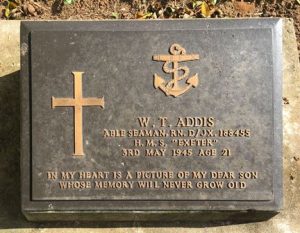
Alwyne Robert Bowen, 1187036, Royal Air Force Volunteer Reserve. Alwyne was the son of Robert Bowen and Margaret Ellen Bowen (nee Roberts), of Railway Terrace, Pant. He enlisted into the Royal Air Force Volunteer Reserve in August 1940, and after training as a Wireless Operator/ Air Gunner was posted to 115 Squadron, RAF. The squadron was a heavy bomber unit, based at RAF East Wretham, and flew the Vickers Wellington. Just before midnight on 25 July 1942, Alwyne took off from Wretham aboard Wellington III, Serial Z1606, which was part of a flight of 313 aircraft sent to bomb targets in Duisberg. On the following morning, 26 July 1942, Alwyne’s Wellington crashed near Krefeld, Germany, killing all five men aboard. Alwyne was 21-years-old when he died that day, and was originally buried alongside his fellow crewmen in Krefeld Main Cemetery, but on 10 June 1947 their remains were re-interred in Reichswald Forest War Cemetery, Germany. Alwyne is not commemorated on the Llanymynech war memorial, but on the Pant war memorial.
Basil Griffiths, Sergeant, 1578754, Royal Air Force Volunteer Reserve. Basil was the son of Robert David Griffiths and Amy Cicily Griffiths, of Shirley Gorse, Pant. He enlisted into the Royal Air Force Volunteer Reserve, and after training as a Flight Engineer was posted to 75 Squadron, RAF. The squadron had been reformed as a heavy bomber squadron in 1937, equipped with the Avro Anson. In April 1940 the squadron moved to RAF Feltwell, re-equipping with the Vickers Wellington and was renamed to 75 (New Zealand) Squadron. By June 1943 the squadron had moved to RAF Mepal, and was equipped with the Short Stirling and the Avro Lancaster. On the night of 15/16 June 1944, Basil took off from Mepal aboard Lancaster LL888, as part of a large force despatched to bomb enemy shipping at Le Havre, On the return flight the following morning, 16 June 1944, Basil’s Lancaster was attacked by German night-fighters, and crashed near Rieux, killing all her crew of seven men. Basil was 22-years-old when he was killed that morning, and is buried beside his fellow crew-men in Rieux Communal Cemetery, France.
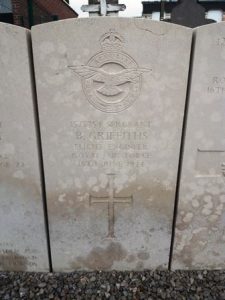
Llewellyn Roberts, Pilot Officer, 52038, Royal Air Force. Llewellyn was the son of Thomas Morris Roberts, and of Edith Roberts (nee Edmonds), of Idris Cottage, Pant. He enlisted into the Royal Air Force as a young man in 1937, and trained as a Wireless Operator. He was reportedly awarded the Distinguished Flying Medal in 1943. On 13 March 1943 he was commissioned as a Pilot Officer, joining 161 Squadron, Royal Air Force. The Squadron was an elite and secretive unit, formed to carry out missions as part of the Royal Air Force Special Duties Service. It was tasked with missions for the SOE and SIS, dropping and collecting secret agents and equipment into and from Nazi-occupied Europe. The squadron had been formed at Newmarket, equipped with Lysander’s, Whitley’s and Wellington’s, then in April 1942 joined 138 Squadron at RAF Tempsford in Bedfordshire, where the Whitley’s were replaced by the Avro Halifax. At 23.20 on 11 June 1943, Llewellyn took off from Tempsford aboard Halifax V, Serial DG406, on SOE Operation Physician 32 and Charlotte. The aircraft was lost without a trace on the following morning, 12 June 1943. Llewellyn, who was 23-years-old, has no known grave, and is commemorated alongside his six other crewmen on the Runnymede Memorial, Surrey.
Richard Noel Lloyd-Hughes, Aircraftman 2nd Class, 966659, Royal Air Force Volunteer Reserve. Richard was born in Liverpool in 1920, but his family then moved back to their native Llanymynech. He enlisted into the Royal Air Force Volunteer Reserve, and was posted to Egypt to join 208 Squadron, RAF. The squadron flew Westland Lysander reconnaissance aircraft and Hawker Hurricane fighters on army co-operation duties in the North African Campaign and the Greek Campaign of 1941. Very little else is known of Richard, except that he died in hospital in Cairo on 22 March 1941. The 21-year-old is buried in Cairo War Memorial Cemetery, Egypt.
